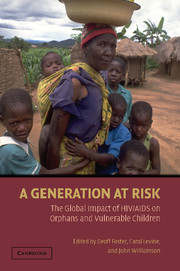Book contents
- Frontmatter
- Contents
- Foreword
- Preface
- Contributors
- Introduction: HIV/AIDS and Its Long-Term Impact on Children
- 1 Family and Community-Based Care for Children Affected by HIV/AIDS: Strengthening the Front Line Response
- 2 Strengthening Households and Communities: The Key to Reducing the Economic Impacts of HIV/AIDS on Children and Families
- 3 The Response of the Educational System to the Needs of Orphans and Children Affected by HIV/AIDS
- 4 Psychosocial Impact of the HIV/AIDS Epidemic on Children and Youth
- 5 Human Rights and Children Affected by HIV/AIDS
- 6 Religion and Responses to Orphans in Africa
- 7 Making the Right Choices in the Asia-Pacific Region: Protecting Children and Young People from HIV and Its Impacts
- 8 Troubled Tapestries: Children, Families, and the HIV/AIDS Epidemic in the United States
- 9 Interventions to Support Children Affected by HIV/AIDS: Priority Areas for Future Research
- 10 Finding a Way Forward: Reducing the Impacts of HIV/AIDS on Vulnerable Children and Families
- Chronology of Important Events
- Resource Guide
- Index
- References
10 - Finding a Way Forward: Reducing the Impacts of HIV/AIDS on Vulnerable Children and Families
Published online by Cambridge University Press: 05 June 2012
- Frontmatter
- Contents
- Foreword
- Preface
- Contributors
- Introduction: HIV/AIDS and Its Long-Term Impact on Children
- 1 Family and Community-Based Care for Children Affected by HIV/AIDS: Strengthening the Front Line Response
- 2 Strengthening Households and Communities: The Key to Reducing the Economic Impacts of HIV/AIDS on Children and Families
- 3 The Response of the Educational System to the Needs of Orphans and Children Affected by HIV/AIDS
- 4 Psychosocial Impact of the HIV/AIDS Epidemic on Children and Youth
- 5 Human Rights and Children Affected by HIV/AIDS
- 6 Religion and Responses to Orphans in Africa
- 7 Making the Right Choices in the Asia-Pacific Region: Protecting Children and Young People from HIV and Its Impacts
- 8 Troubled Tapestries: Children, Families, and the HIV/AIDS Epidemic in the United States
- 9 Interventions to Support Children Affected by HIV/AIDS: Priority Areas for Future Research
- 10 Finding a Way Forward: Reducing the Impacts of HIV/AIDS on Vulnerable Children and Families
- Chronology of Important Events
- Resource Guide
- Index
- References
Summary
The number of children and families made vulnerable by HIV/AIDS is massive and will remain so for decades. As the previous chapters have shown, the pandemic is causing unprecedented child and family welfare problems, and the collective response in every seriously affected country falls far short of what is needed. What affected children and families require and what their own countries and the international community owe them is a combination of efforts, large and small, that collectively match the scale and duration of the impacts of AIDS. However, only a small percentage of children and families affected by HIV/AIDS are currently benefiting significantly from assistance from outside their own extended family (USAID, UNAIDS, WHO, UNICEF, and The Policy Project 2004:27). While many effective programs are in operation, there remains a huge gap between the results of these initiatives and what needs to be done. This chapter recommends strategies and interventions that, taken together, would begin to close the gap between what is being done and what must be done.
THE ELEMENTS OF AN ADEQUATE AND EFFECTIVE RESPONSE
By itself, no single intervention will make a sufficient impact on the full range of economic and psychosocial problems HIV/AIDS is causing among children and families, because the problems are too many and too varied. What is needed is a planned and coordinated set of policy, social-mobilization, and programmatic interventions by public sector and civil society actors.
- Type
- Chapter
- Information
- A Generation at RiskThe Global Impact of HIV/AIDS on Orphans and Vulnerable Children, pp. 254 - 278Publisher: Cambridge University PressPrint publication year: 2005
References
- 4
- Cited by

